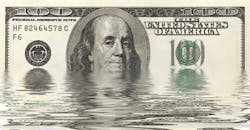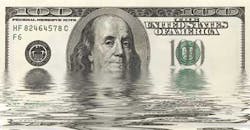By Oliver Lawal
According to the World Economic Forum, water security "is one of the most tangible and fastest-growing social, political and economic challenges faced today." In fact, it recognized water scarcity as the "second most important risk facing the world in the years ahead."
So why can I walk into any restaurant and get a glass of water for free?
Not only can I get a glass of water for free but, like most other households in the developed world, mine literally pours vast amounts down the drain. At a recent meeting in Davos, Switzerland, U.N. Secretary-General Ban Ki-moon reminded us that "most of us do not appreciate water." We commonly say that someone with a lavish lifestyle is "spending money like water."
Indeed both on micro- and macro-economic levels we are spending money like water. Yet with the exception of those directly involved in the water industry, most people do not think about spending money on water. This is not a sustainable position for the human race. Sooner or later we have to increase spending on water. Those of us within the water industry have an obligation to ensure that spending is directed appropriately.
Water consumers, both private and commercial, must make wise choices when selecting and operating appliances and equipment. Some companies, such as Nestle, P&G, Halliburton and General Mills, are increasingly honest about the fact that they are making such choices based not on a sense of charity but on self-interest.
No longer are environmental concerns the sole driver for water reuse and conservation. According to a 2012 Carbon Disclosure Project (CDP) report, "demand for water is projected to outstrip supply by a staggering 40 percent by 2030." But this is not just a future problem; the U.S. Department of Agriculture declared more than 50 percent of U.S. counties as natural disaster areas because of extreme drought in 2012. According to the same CDP report, 53 percent of the Global 500 companies have experienced detrimental water-related business impacts, such as business interruption and property damage from flooding.
Regulators and legislators have an important role to play in ensuring that our spending on water is both enabled and appropriate. We cannot afford to allow myopic views to restrict much-needed improvements. To be clear, these views are not exclusively owned by those in the public sector. It is too easy to draw lines in the sand when it comes to regulation; however, there are positive examples of regulation providing market enablers. It is imperative that both public and private sectors work together to seek out those positive examples and build upon them.
Now, a call to equipment manufacturers and design engineers: Let's help make a robust business case for the investment in water management. Let's continue to work hard on proposing innovative solutions, but let's work even harder to deliver on the promises those solutions can provide. Let's embrace those business leaders and regulators who seek a more inclusive approach, and let's increase our efforts to persuade those who do not.
Water is a renewable - yet not inexhaustible - resource. It cannot withstand constant over-extraction and being depleted faster than being renewed. Water is different from other challenges because it cannot be substituted. So let us consider more spending on water, not more spending like water.
About the Author: Oliver Lawal is president of Aquionics Inc., an Erlanger, Kentucky-based supplier of non-chemical disinfection and microbiological control equipment utilizing Ultraviolet technology. The company's systems are used in a wide variety of applications including municipal water and wastewater treatment, pharmaceutical manufacture, food and beverage production, microelectronics, swimming pools, and specialized industrial settings. Lawal currently serves as a member of the WWEMA Board of Directors.
WaterWorld Articles Archives




